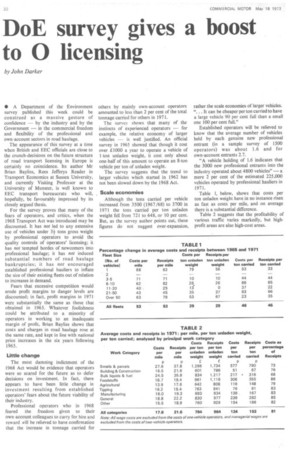DoE survey gives a boost to 0 licensing
Page 24

If you've noticed an error in this article please click here to report it so we can fix it.
by John Darker
• A Department of the Environment survey published this week could be construed as a massive gesture of confidence by the industry and by the Government — in the commercial freedom and flexibility of the professional and own-account sectors in road haulage.
The appearance of this survey at a time when British and EEC officials are close to the crunch-decisions on the future structure of road transport licensing in Europe is certainly no coincidence. Its author Mr Brian Bayliss, Rees Jefferys Reader in Transport Economics at Sussex University, and currently Visiting Professor at the University of Munster, is well known to EEC transport bureaucrats who will, hopefully, be favourably impressed by its closely argued thesis.
For the survey proves that many of the fears of operators, and critics, when the 1968 Transport Act was introduced may be discounted. It has not led to any extensive use of vehicles under 3+ tons gross weight by professional operators to avoid the quality controls of operators' licensing; it has not tempted hordes of newcomers into professional haulage; it has not induced substantial numbers of road haulage bankruptcies; it has not encouraged established professional hauliers to inflate the size of their existing fleets out of relation to increases in demand.
Fears that excessive competition would erode profit margins to danger levels are discounted; in fact, profit margins in 1971 were substantially the same as those that obtained in 1965. Whatever foolishness could be attributed to a minority of operators in working to an inadequate margin of profit, Brian Bayliss shows that costs and charges in road haulage rose at the same rate, and kept in line with national price increases in the six years following 1965.
Little change The most damning indictment of the 1968 Act would be evidence that operators were so scared for the future as to defer decisions on investment. In fact, there appears to have been little change in investment resulting from established operators' fears about the future viability of their industry.
Professional operators who in 1968 feared the freedom given to their own-account colleagues to carry for hire and reward ,vill be relieved to have confirmation that the increase in tonnage carried for others by mainly own-account operators amounted to less than 2 per cent of the total tonnage carried for others in 1971.
The survey shows that many of the instincts of experienced operators — for example, the relative economy of larger vehicles — is well justified. An official survey in 1965 showed that though it cost over £1000 a year to operate a vehicle of 1-ton unladen weight, it cost only about one-half of this amount to operate an 8-ton vehicle per ton of unladen weight.
The survey suggests that the trend to larger vehicles which started in 1962 has not been slowed down by the 1968 Act.
Scale economies Although the tons carried per vehicle increased from 3500 (1967/68) to 3700 in 1971 the tons carried per ton unladen weight fell from 721 to 648, or 10 per cent. But, as the survey author points out, these figures do not suggest over-expansion,
rather the scale economies of larger vehicles. ". . . It can be cheaper per ton carried to have a large vehicle 90 per cent full than a small one 100 per cent full."
Established operators will be relieved to know that the average number of vehicles held by each genuine new professional entrant (in a sample survey of 1500 operators) was about 1.6 and for own-account entrants 2.7.
"A vehicle holding of 1.6 indicates that the 3000 new professional entrants into the industry operated about 4800 vehicles" — a mere 2 per cent of the estimated 225,000 vehicles operated by professional hauliers in 1971.
Table 1, below, shows that costs per ton unladen weight have in no instance risen as fast as costs per mile, and on average there is a substantial difference.
Table 2 suggests that the profitability of various traffic varies markedly, but highprofit areas are also high-cost areas.
















































































































